
Victoria Jones/PA Wire via AP


Victoria Jones/PA Wire via AP

Liu Jie/Xinhua via ZUMA Wire
As social distancing measures were rolled out across the country over the last month and a half, Florida, Wisconsin, Ohio, Illinois, and other states have illustrated the inconvenience, risk, and deadly nature of holding elections in the midst of deadly viral outbreak. Among the trillions of dollars allocated in the first major Congressional initiative responding to the pandemic—late March’s Coronavirus Aid, Relief, and Economic Security Act—was $400 million to help states stage voting amid the crisis. But unlike other funds provided in the act, the money came with a catch: States would need to put up a 20 percent match to get their share.
In some states that would take legislative approval, which may not be possible in pandemic-shuttered state capitals. The requirement also saddles states with a multi-million dollar expense just as they face looming budget shortfalls totaling billions of dollars due to the economic slowdown prompted by the virus.
Typically, such a state match “sounds fine and dandy,” says Sen. Amy Klobuchar (D-Minn.), who is the ranking member of the Senate Rules Committee, which has some jurisdiction over election-related issues, where she is working to eliminate or waive the requirement in Congress’s next round of coronavirus support legislation.
“You like to have people have skin in the game when you’re giving money to states in normal circumstances,” she told Mother Jones. “We’re not in a normal circumstance. Just as we didn’t require matches for hospital money, this is a pandemic. It’s a national emergency.”
Since the legislation, most states have requested the funding, according to the Center for Public Integrity, indicating that many local officials believe they will be able to meet the requirement. But some states won’t. In Arizona, the state legislature has gone into indefinite recess because of the pandemic and can’t approve its matching portion. In Maine, the legislature is also adjourned; even if it were not, an official there told CPI that the coming coronavirus-related budget hit means the state legislature “is not going to be sympathetic” to requests for additional election money. Other states, such as Utah, may decline to take all the federal money on offer so they don’t have to come up with the full match.
On April 2, Iowa Secretary of State Paul Pate, who serves as president of the National Association of Secretaries of State, wrote a letter to both parties’ House leadership warning of “significant challenges when it comes to accessing these federal funds,” including that many legislatures have adjourned. Pate also pointed out that requirements that the money be spent or allocated by the end of 2020 “may be complicated” due to procurement laws, supply chain issues and “a scarce supply of necessary cleaning products and personal protective equipment available.”
The match requirement is consistent with previous Congressional appropriations of election assistance funding dating back to the original passage of the Help America Vote Act in the wake of the 2000 presidential election and that year’s recount in Florida. The coronavirus package match requirement is the third time states have had to put money up for federal election funding assistance since 2016, including $380 million in March 2018 that required a 5 percent state match and $425 million in January tied to a 20 percent match. After the CARES act passed in March, Klobuchar says her staff “immediately” heard from states complaining about the match. She’s hopeful that colleagues in both parties will work with her to make further funding available without state participation.
“We’re in a pandemic,” she says. “I get why you’d do it, but it just doesn’t work in this situation.”
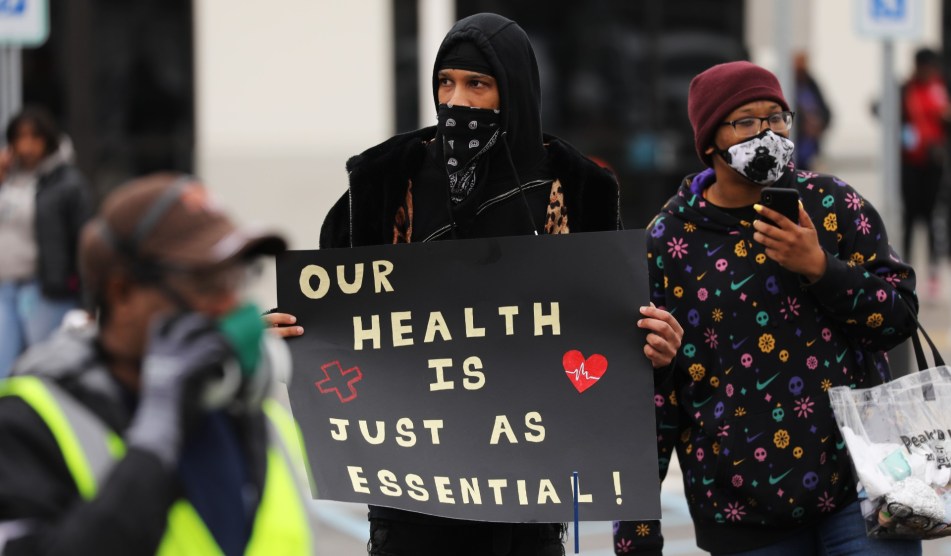
Spencer Platt/Getty
Hundreds of Amazon workers have pledged to walk out of the fulfillment centers where they work on Tuesday across the country in a nationwide protest demanding more protections during the coronavirus pandemic, including paid leave, face masks, and temperature checks. Tuesday’s strike is part of a growing movement of protests by blue-collar tech workers across industries pushing companies to put their workers’ wellbeing above profits.
United For Respect—an advocacy group that helped organize the strike and a member of the Athena coalition, a national network of organizations working to “stop Amazon’s injustices”—called it “the biggest mass action by workers yet.” Amazon, in a statement, called the numbers of protestors “grossly exaggerated.” The company said safety measures, including masks, temperature checks, and hand sanitizer, are “standard” across facilities.*
Workers are worried about contracting the virus at Amazon’s fulfillment centers, which are notorious for extreme work standards, and say that the increased demand for Amazon products due to shelter in place orders haven’t been met with sufficient safety protocols. Workers in over 130 Amazon facilities have tested positive for COVID-19, says United For Respect. And complaints with the Occupational Health and Safety Administration asking for probes of labor conditions have been filed in Minnesota and California.
As I reported last month, workers at a facility in Staten Island went on strike in protest of workplace conditions. One organizer, Christopher Smalls, was subsequently fired. (Amazon says this is because Smalls, who had been in contact with someone who tested positive for COVID-19, broke his 14-day quarantine by attending the protest.)
At a meeting of company executives attended by Jeff Bezos, Amazon General Counsel David Zapolsky said it would be good to have the news focus on Smalls instead of the company because, according to a memo leaked to Vice, “He’s not smart, or articulate.” (Zapolsky has since said his comments were “personal and emotional.”)
This morning, Smalls tweeted (from @Shut_downAmazon) a “friendly reminder.” A poster, it reads at the bottom: “they can’t stop all of us from fighting for the protections we need.”
Just a friendly reminder Good Morning 🌎🙏🏽 #solidarity #ChrisSmalls pic.twitter.com/cWmvi0qaX1
— Christian Smalls (@Shut_downAmazon) April 20, 2020
*This post has been updated to reflect a statement by Amazon made after initial publication.
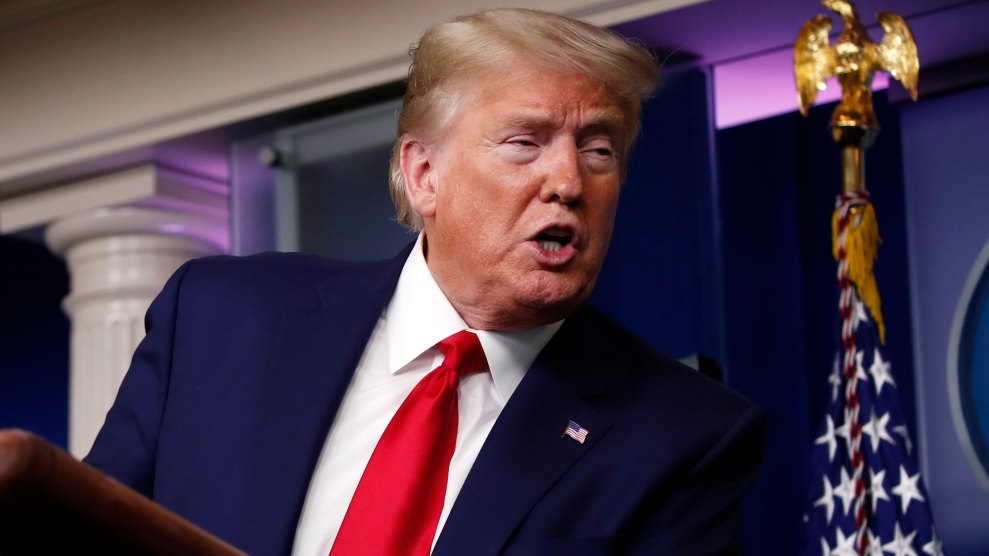
Alex Brandon/AP
“Hundreds and hundreds of labs are ready, willing, and able. Some of the governors, as an example, the governor of Maryland didn’t understand too much about what was going on,” Trump told reporters. “So now he’ll be able to do that. It’s pretty simple. They have tremendous capacity, and we hope to be able to help him out.” Later in the briefing, Trump added: “The governor of Maryland could have called Mike Pence and saved a lot of money. He didn’t need to go to South Korea. I think he needed to get a little bit of knowledge.”"The governor of Maryland didn't really understand. He didn't really understand what was going on" — Trump begins the April 20 #TrumpPressBriefing by attacking Republican Gov. Larry Hogan of Maryland, who has been critical of the federal coronavirus response. pic.twitter.com/OTMwj6v5Sp
— Aaron Rupar (@atrupar) April 20, 2020
Pres Trump: "It used to be ventilators, ventilators, ventilators. Now, it's testing, testing, testing."
— Yamiche Alcindor (@Yamiche) April 20, 2020
Note: Access to testing has been an issue for months. Governors, business leaders & every day people have been sounding the alarm for months that there are not enough tests.
Despite praising states’ COVID-19 testing capacity, the fact is that governors have repeatedly said the opposite: Democratic and Republican governors alike have rejected the administration’s optimistic take and have demanded more tests before they decide to re-open their economies. Researchers have argued that the number of tests per day, currently at 150,000, needs to triple before cities could begin easing shelter-in-place policies. On Sunday, after Pence said on NBC’s Meet the Press that “there is a sufficient capacity of testing across the country today for any state in America” to begin lifting social distancing restrictions, Hogan, who serves as chairman of the National Governors Association, pushed back on the administration’s criticism that governors hadn’t taken advantage of testing. Hogan told CNN’s State of the Union: “To try to push this off, to say that the governors have plenty of testing and they should just get to work on testing—somehow we aren’t doing our job—is just absolutely false.” Hogan went on:Trump singles out JB Pritzker, Illinois governor who has been sharply critical of the fed response, and says: “Some states have far more capacity than they actually understand … Some of the governors didn’t understand it.”
— Manu Raju (@mkraju) April 20, 2020
The administration, I think, is trying to ramp up testing, and trying — they are doing some things with respect to private labs. But to try to push this off to say that the governors have plenty of testing, and they should just get to work on testing, somehow we aren’t doing our job, is just absolutely false. Every governor in America has been pushing and fighting and clawing to get more tests, not only from the federal government, but from every private lab in America and from all across the world. And we continue to do so. Look, we have increased our testing in Maryland by 5,000 percent over the past month, but it’s nowhere near where it needs to be. And, as Governor Northam said a moment ago, there are things like shortages on swabs that we don’t have anywhere in America that you can’t do the test without, on reagents, which is a part of the test. So, look, I think they have made some strides at the federal level. I think states are all working hard on their own to find their own testing. Lab capacity has been increasing. But it’s not accurate to say there’s plenty of testing out there, and the governors should just get it done. That’s just not being straightforward.
Maryland Gov. Larry Hogan says Trump's claim that states have enough tests to reopen "is just absolutely false."
— Kyle Griffin (@kylegriffin1) April 19, 2020
"It's not accurate to say there's plenty of testing out there and the governors should just get it done. That's just not being straightforward." Via CNN pic.twitter.com/0Z37AHBuii
Despite warnings from public health officials that reopening the economy too soon could lead to a spike in coronavirus cases, Georgia’s Republican governor, Brian Kemp, announced Monday that gyms, hair and nail salons, and bowling alleys would open back up on Friday. Restaurants and movie theaters are slated to open the following Monday, April 27.
South Carolina and Tennessee have similarly relaxed restrictions on non-essential businesses, following a push from President Trump to allow some governors to reopen their states on or before May 1. Trump’s benchmarks for reopening recommend that states see steady declines in coronavirus cases for 14 days, that their hospital systems not be overwhelmed, and that they have robust testing available before reopening. Going into Monday, Georgia had seen five straight days of declines in new positives; the longterm trend is uncertain.
Dr. Anthony Fauci has cautioned against states reopening too quickly, telling the Associated Press, “I’ll guarantee you, once you start pulling back there will be infections.” He warned that without aggressive testing and contact tracing, case counts could skyrocket.
Meanwhile, 18,947 people in Georgia have tested positive for the coronavirus, and 733 people have died. As one Twitter user noted, Georgia’s schools are set to remain closed for the remainder of the school year.

Kevin Winter/Getty
A week and a half ago, public health officials in Los Angeles County reported that 8,430 people in the county had been infected with COVID-19 since the start of the coronavirus pandemic. But according to preliminary results from a new study, the actual number of cases was likely in the hundreds of thousands.
Researchers are now estimating that between 221,000 and 442,000 adults in Los Angeles County had been infected with COVID-19 by early April, officials announced at a press conference today. The study, conducted by researchers at the University of of Southern California and the county public health department, collected blood samples from about 863 adults at drive-through testing sites between April 10 and 14, then looked for COVID-19 antibodies in their blood. They found that between 2.8 to 5.6 percent of those tested had developed antibodies to the virus.
“This gives us a better understanding of how much of our population has, at some point in time, been positive, been infected with the COVID-19 virus, regardless of whether they were ever tested or they even ever had any symptoms,” said Barbara Ferrer, director of the Los Angeles County Department of Public Health. “There are many, many people throughout the county who are positive for COVID-19 who may not be showing any symptoms.”
These findings have good and bad implications, according to Neeraj Sood, the professor at the University of Southern California’s public policy school who co-led the study. The good: COVID-19 is probably less deadly than previously thought, since past mortality rates were based on a much smaller number of confirmed cases. But even though researchers now believe that hundreds of thousands of Los Angeles area residents have been infected, that’s still only about four percent of the county’s population, Sood pointed out. “We are very early in the epidemic,” he said. “Many more people in LA County could potentially be infected. As those number of infections rise, so will the number of deaths, the number of hospitalization, and the number of ICU admissions.”
According to the Los Angeles Times, the findings echo results released last week by Stanford University researchers, who conducted antibody tests in Santa Clara County, one of the earliest and hardest-hit counties in California. Their study found that as many as 81,000 residents had been infected by early April, when the county was reporting about 1,000 confirmed cases. Yet the Santa Clara study has proved controversial among statisticians who argue that the results may not be accurate in part because the test supplier, Premier Biotech, reported to the FDA that that 2 out of every 371 tests were false positives.
Participants in the LA County study, which also used Premier Biotech tests, were chosen randomly from a database maintained by the LRW Group, a market research firm, with quotas for age, gender, and race, Sood said. The study in Santa Clara County has been criticized for recruiting participants from social media, resulting in a sample that was disproportionately white and female and needed to be adjusted, according to the Mercury News.
While the results from Los Angeles are still preliminary, the discrepancy between the county’s official case count earlier this month and the estimated number of actual infections is yet another sign that widespread testing shortages and delays have contributed to our incomplete picture of the coronavirus’ reach.

An Arizona National Guard helicopter takes off to deliver medical supplies to the remote Navajo Nation on March 31, 2020.Ross D. Franklin/AP
During a Friday morning virtual town hall about coronavirus in Native American communities, Jonathan Nez, president of the Navajo Nation, said he could no longer hold back frustration at “the slow pace at which our federal government has worked to get dollars out to Indian Country.” Echoing the concerns of other Indigenous leaders and health officials on the call, which was organized by the Democrats of the House Natural Resources Committee, Nez called for immediate direct payments to tribal governments, instead of the lengthy grant-application process that has hindered the Navajo and other Indigenous nations from receiving aid in a time of urgent need.
Nez, who represents one of the hardest-hit communities in the country, also raised alarm that much of the CARES Act’s $8 billion allocation for Native communities would be diverted from tribal governments to “for-profit corporations.” He was alluding to revelations made last week by Indianz.com that Alaska Native corporations—non-governmental entities that rank among the largest businesses in Alaska—would be eligible to apply for emergency funds. Given the massive size of their land holdings, such corporations could end up receiving as much as half of the $8 billion, according to the National Indian Gaming Association.
On Thursday, a coalition of five tribes filed suit against the Department of Treasury, alleging that its classification of Alaska Native corporations as “tribal governments” for the sake of making payments is illegal and neglects the federal government’s trust responsibilities to Native tribes during the COVID-19 pandemic. In all states, it is tribal governments and not corporations who “are responsible for providing critical needs such as healthcare,” said Teri Gobin, chair of the Tulalip Tribes, who are plaintiffs in the suit. “We are struggling right now because we have no revenue coming in, and it’s going to take years to recover.”
Many legislators and tribal leaders who supported the CARES Act believed the $8 billion allocation would exclusively support tribal governments. On Thursday, Senate Minority Leader Chuck Schumer scuffled on Twitter with Tara Sweeney, who is advising the Treasury Department on disbursements to Native nations in her role as assistant secretary for Indian affairs. Sweeney previously served as a lobbyist for an Alaska Native corporation, Arctic Slope Regional, of which she remains a shareholder.
@SenSchumer Even for you, this is an ignorant and despicably low attack that could not be further from the truth. Perhaps you should read the law you negotiated and voted for as Alaska Natives are entitled to receive the funding from @USTreasury. https://t.co/6hIAT5Y9qa https://t.co/Yr2OX6clhO
— Assistant Secretary Tara Sweeney (@ASIndianAffairs) April 16, 2020
On Thursday evening, 13 Native organizations demanded Sweeney recuse herself from further decisions about CARES Act funding, given the possible conflicts of interest. Several tribal governments called for her resignation. In a statement, the Department of Interior, which oversees the Bureau of Indian Affairs, said it had reviewed and cleared Sweeney of any potential wrongdoing, adding that any suggestion that “she has personal motives or that she is attempting to divert funds away from American Indians is completely false.”
As entities created by Congress in 1970 to process Indigenous land claims in Alaska, Alaska Native corporations have more diverse revenue streams than most tribal governments and could benefit from other provisions of the coronavirus relief package. Arguing that their own aid would be jeopardized by having to share CARES Act funds with their for-profit counterparts, three Alaska Native tribal governments also joined the lawsuit against the Treasury Department.
During the town hall, Nez said that the cash-strapped Navajo government was still footing the massive bill for its pandemic response, while struggling to bid against state governments for testing kits and personal protective equipment. Though unsure when relief would arrive, “we are saving all the receipts,” said Nez, “and we’re gonna package that up and give to Uncle Sam, and ask for our reimbursements.”
As of Friday, the Navajo Nation had at least 1,042 confirmed cases of COVID-19, while the state of Alaska had just over 300.
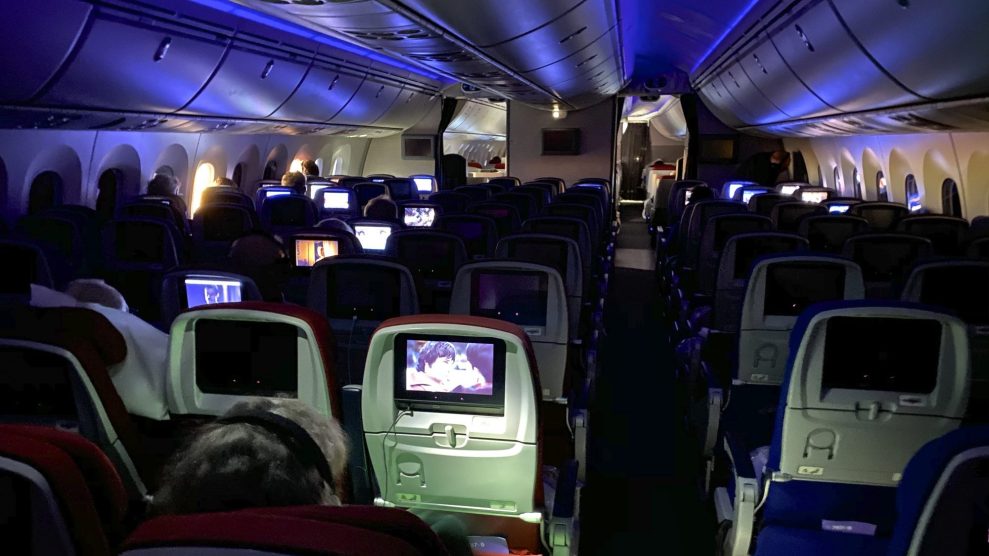
A nearly empty flight.Kike Calvo/Zuma
This piece was originally published in the Guardian and appears here as part of our Climate Desk Partnership.
The coronavirus outbreak has provoked a string of unsettling sights, such as the sudden widespread use of masks, shuttered businesses and deserted streets. Another unusual phenomenon is also playing out in the skies—near-empty airplanes flying through the air.
Widespread travel restrictions around the world have slashed demand for air travel, with more than eight in 10 flights canceled. But there is a disparity in the US—while the Transportation Security Administration (TSA) has reported a 96 percent slump in passenger volume, to a level not seen since 1954, this hasn’t been matched by the number of flights being scrapped.
Slightly more than half the flights within the US have been canceled, leading to a slew of near-empty flights. Less than one in 10 seats on domestic flights were filled by passengers last week, according to an estimate by Dan Rutherford, aviation director at the International Council on Clean Transportation.
“The evidence suggests that the number of people flying is dropping faster than the flights so there are a lot of empty planes,” he said. “The airlines are left to figure this out for themselves and they are playing catch-up.”
This situation is leading to a “huge environmental waste,” Rutherford said, as planes burn huge amounts of fuel to transport just a handful of people around America.
In March, Sheryl Pardo shared a video of her being upgraded to first class and given a personalized safety briefing after being the only passenger to check in to an American Airlines flight from Washington to Boston. Meanwhile, a Virgin Atlantic flight from London to New York subsequently carried just seven people.
The aviation industry accounts for about two percent of global carbon emissions, although this is concentrated among the small fraction of the world’s population that regularly flies. The reduction in flights is expected to reduce pollution levels, with emissions from the sector dropping by almost a third last month, the Financial Times has reported.
However, passenger numbers may well bounce back quickly following the end of the COVID-19 crisis.
“You have dips around recessions but within two or three years it returns,” said Rutherford. “I imagine leisure travel will recover pretty quickly. In the boom years, airlines have eased off on attempts to improve fuel efficiency—what was going on was not sustainable. The million-dollar question is whether we will curb flying to protect the climate, as we are now doing to protect public health.”
The US airline industry got $25 billion in assistance in the recent stimulus package to deal with the sharp downturn in business. In return, the airlines are required to maintain a certain level of service, which may be leading to the near-empty flights.
The economics of running an airline can also be counterintuitive in that it can sometimes be cheaper to fly a commercial airliner to a planned destination than pay for a spot to simply park it.
According to Airlines for America, an industry group, more than a third of the US fleet, about 2,400 aircraft, have been parked, with airlines burning through cash at more than $10 billion a month as cancellations “far outpace” new bookings. Planes have gone from “load factors” of 80 percent in January to just 11 percent in April.
“The novel coronavirus pandemic has had, and continues to have, a severe and unprecedented impact on the US airline industry,” a spokeswoman for the lobby group said, adding that flights are also shifting important cargo such as medical supplies, food and mail.
Doug Parker, chief executive of American Airlines, said: “Those that are flying today are doing so for important reasons.”
A spokesman for United said it was “still somewhat rare” for a single passenger to be on a flight and said that the company had made investments in more sustainable fuel to lower its carbon footprint.
The commitment of airlines in general to addressing the climate crisis has been questioned during the coronavirus shutdown, however. Airlines are lobbying to rewrite the rules of a global agreement designed to tackle aviation emissions, with the coronavirus outbreak expected to make its targets tougher to meet.
Campaigners accused airlines of attempting to “dodge their obligations,” but the industry said it was “a matter of survival.”
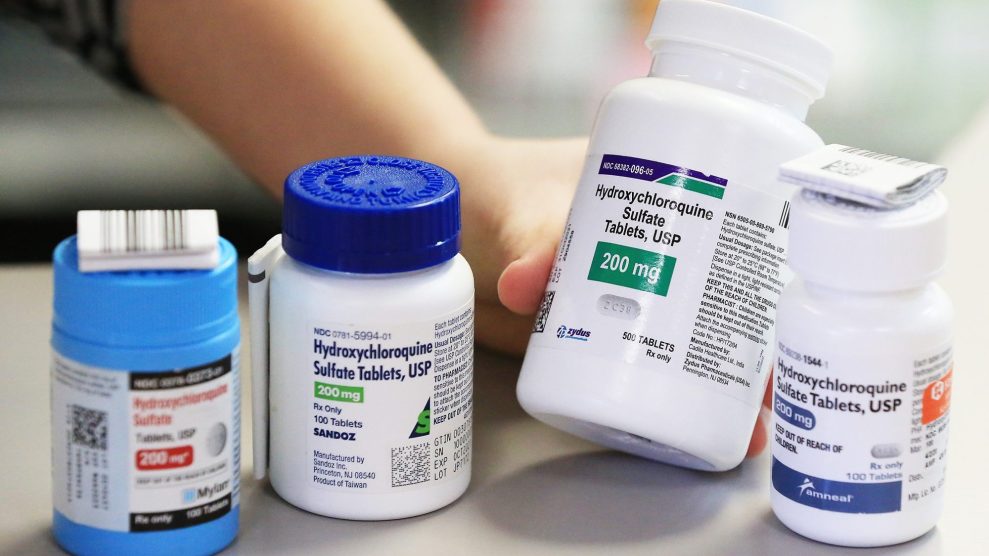
A variety of manufacturers providing hydroxychloroquine.Kevin E. Schmidt/Zuma
For weeks, President Trump has touted the anti-malarial drug hydroxychloroquine (HCQ) as an effective treatment for COVID-19, which has killed nearly 36,000 Americans and infected more than 680,000. On Tuesday this week, the president referred to HCQ, typically used to treat patients with auto-immune disorders like lupus, as “pretty amazing…I haven’t heard a bad story.” In fact, the president hasn’t ruled out an HCQ regiment for himself. During an April 5 press conference, he said, “I may take it. And I’ll have to ask my doctors about that, but I may take it.”
The medical community is more circumspect. The validity of two recent studies by a French doctor touting its effectiveness against COVID-19 with 42 and 80 patients, respectively, has been questioned by the medical community for a lack of objective requirements met by the studies; in one, the doctor broke norms by hand-picking the control group, and the second lacked a control group entirely. Another study, in Brazil, used HCQ and a related drug, chloroquine, on COVID-19 patients. At strong doses, both are known to cause heart arrhythmias, and after 11 patients on a high-level chloroquine regimen died, the study was discontinued. Another French study simply found it to be ineffective.
Nonetheless, many doctors have used the drug when it seems as if options for patients were running out. Anecdotally, some physicians in the United States and abroad have acknowledged some success in using HCQ in the fight against the coronavirus. Under pressure from the Trump administration, the Food and Drug Administration and Department of Health and Human Services have passed measures to ramp up its use in hospitals—and several clinical trials are simultaneously underway to determine HCQ’s efficacy.
To better understand HCQ, its origins, and its potential risks, I spoke to Dr. Remington Nevin, a Vermont-based doctor who runs the Quinism Foundation, which advocates greater awareness of the neurological risks tied to quinoline, the broader category of drugs that HCQ falls under. Before establishing the foundation, Dr. Nevin spent 14 years in the military as an epidemiologist, where he saw the effects of another quinoline, mefloquine, an anti-malarial that was regularly administered to soldiers, some of whom sued the military for debilitating side effects. Service members reported insomnia, anxiety, dizziness, vertigo, and paranoia—symptoms concerning enough that the military largely ended its use of the drug in 2009. In 2013, the FDA placed a “black box warning”—its strongest advisory—on use of the mefloquine.
The following interview has been edited for length and clarity.
Could you walk me through the origins of these drugs?
Drugs of this class, quinoline, are among the oldest drugs still in use in medicine. Quinine, the prototypical drug of this class, is a naturally occurring substance found in the bark of the cinchona tree, which was first discovered many centuries ago in South America. The anti-malarial properties of cinchona became widely known early on. This drug, and its anti-malaria properties, essentially permitted European colonization of Africa—and to a lesser extent, Asia and South East Asia. The gin and tonic was once used medicinally by British troops to protect them to a certain degree from malaria.
In the United States, we have used quinine since Revolutionary War days. As the Second World War was approaching in the late 1930s and as our military was anticipating the possibility of significant land battles in the South Pacific, we become aware of an imminent shortage of quinine because Cinchona plantations were effectively under quarantine by the Axis powers, in Java. Then began a search for synthetic alternatives that we could prescribe to our troops in event of war in the South Pacific. We settled on a particularly toxic alternative to quinine, called quinacrine.
The drug’s toxic properties were very well known to senior military leadership at the time, but it was felt that we had no choice but to use this drug because if we didn’t, it would mean the certain deaths of thousands, if not tens of thousands of troops to malaria, if fighting began in the South Pacific. As the conflict began, the US undertook an extraordinary effort to search for superior synthetic alternatives to quinine, particularly quinacrine. That effort lead to the discovery of—or I should say rediscovery—of chloroquine. Chloroquine had been first synthesized by the Germans in the 1930s. But after some initial human clinical testing, it was deemed too toxic for human use. For whatever reason, the US military decided to further its development of chloroquine and ultimately found it to be superior to quinacrine.
Quinoline-class drugs all share a tendency to cause neuropsychiatric effects that are referable to specific parts of the brain and brain stem. With quinacrine, we knew early on that this drug could cause a severe psychosis—a delusional, paranoid psychosis in troops taking the drug. In World War II, this information was deemed restricted, subject to controls on its dissemination. It was only after war that we saw the publication of some truly extraordinary papers that described just how commonly quinacrine caused mild, moderate and severe psychiatric symptoms in our deployed troops.
The FDA recently approved the both chloroquine and hydroxychloroquine (HCQ) for use to treat COVID-19. What’s the difference between them?
Chloroquine was recognized early on as being fairly poorly tolerated at the doses needed to treat malaria—it was seen to cause symptoms such as dizziness, vertigo, and acute changes in vision—so a search was underway to find a better-tolerated version of chloroquine, and that resulted in the synthesis in 1950 of HCQ.
It was tested in the fruit plantations of the Americas, and was generally found to have reasonable anti-malarial activity, but ultimately it was decided that HCQ was not well suited for use as an anti-malarial, and that chloroquine would continue in use as the anti-malarial drug of choice.
During the Second World War, some troops known to have rheumatological and dermatological problems—that we know today are hallmarks of autoimmune disease—actually saw their conditions get somewhat better as a result of being on quinacrine prophylaxis. So the rheumatological community adopted the use of quinacrine in the years following the war. But it was recognized to cause the same neuropsychiatric problems that marred its use as an anti-malarial.
When HCQ became available, as a supposedly better tolerated form of chloroquine, it was explored for use in autoimmune diseases. It found quite a niche there and has been a mainstay of therapy for many rumotoulogical conditions since its licensing in 1955. But it’s important to note that HCQ, at the time of its licensing, was never subjected to the type of quality, randomized, blind control studies that drugs today would undergo.
What concerns me about HCQ is that most studies of its use in rheumatology show that a not-insignificant part of the population discontinues it for whatever reasons. My concern with the sudden expansion of use of HCQ is that clinicians may not be familiar with the fact that a fraction of the general population who start the drug will need to discontinue it, quite possibly for neuropsychiatric symptoms. The general physician may erroneously assume that the drug is well tolerated by all.
Does that mean that even though the specific numbers aren’t quantified, the legacy of neurological conditions from this class of drugs likely continues with HCQ?
We hope and reasonably can expect that the risk of neuropsychiatric effects with HCQ will be less than with chloroquine—and particularly quinacrine—but these drugs, all quinoline drugs, can function as idiosyncratic neurotoxicants. To define this term a little better: All of these drugs at a high-enough dose will very likely introduce a characteristic type of neurotoxicity, with such symptoms as anxiety, confusion, psychosis, and memory impairment, with neurological symptoms such as vertigo, tinnitus, visual disturbances, and paresthesias. This is the clinical disorder we call quinism, that is caused by a poisoning from this class of drug.
The drugs vary in their threshold for this effect, and individuals also vary significantly in their susceptibility to these effects. We can’t rule out possibility that some individuals will be extraordinarily susceptible to HCQ, even at the low doses used to attempt to prevent COVID-19.
Under normal circumstances today, does chloroquine retain any sort of clinical purpose? Why would the FDA free up both for use against COVID-19 if HCQ is the successor to chloroquine?
Because HCQ was developed as a safer version of chloroquine, you can assume that there was a desire to maintain the efficacy of chloroquine while reducing the risk. Unfortunately, what appears to have happened is that by reducing the risks from the drugs—through the addition of the hydroxy group—the efficacy of the drug has decreased somewhat. I believe the rheumatology community still employs chloroquine, and even quinacrine, for very severe cases of disease not responsive to HCQ. The properties that render this class of drug toxic, also appear to be what renders them effective. The more toxic, the more effective they’ll be. This applies equally to malaria as it does to auto-immune disorders.
The idiosyncratic neurotoxicity that I’m describing does not effect everyone. When this toxicity manifests, it’s typically early during dosing. So you’ll hear many people say, “I’ve taken this drug for years, and not seen side effects.” And that is perfectly expected, and that does not contradict or address our concerns that some individuals are particularly susceptible to these effects during early use. Unfortunately, we don’t have a test to determine who is susceptible and who isn’t. The only way to test is to give them a dose or a few and see if they develop psychiatric symptoms.
Essentially you need to take the leap and administer the drug if you’re to discover if someone is susceptible to these problems.
If neuropsychiatric symptoms develop, then the drug should be discontinued, if that discontinuation doesn’t pose a greater threat to life.
There are always alternatives to using the drug. One could continue social distancing, improve hygiene and wear masks. That’s similar to using these drugs against malaria. It’s a last line of defense after these non-pharmaceutical interventions, such as insect avoidance, using bed nets, wearing appropriate clothing, not going out as night. If those measures fail, anti-malarial drugs would pose a last line of defense. These drugs should never be used as first-line defense to prevent any disease.
What are the implications of all this in terms of the treatment of COVID-19?
There’s adequate and ample theoretical evidence to suggest the potential efficacy of these drugs against COVID-19, but whether that actually translates to effective use in practice is still far from proven. It’s certainly worth exploring, particularly in the context of this current emergency, but as with all experimental drugs, that exploration should be done in a fully transparent and ethical manner with the risks well disclosed to all parties, including the participants. I’m not convinced that that is being done.
The argument for quinolines seems to be that they might have anti-viral qualities, which were explored during SARS and Zika outbreaks. Why does this drug have the potential to be effective against a virus?
There is reasonably strong evidence dating back well over a decade that drugs of this class, chloroquine in particular—and we would expect HCQ to have similar effects—have quite potent anti-viral activity against SARS-like viruses in the lab. There has been fairly strong anecdotal evidence of clinical effectiveness in the few months experience that we’ve had with this virus. Unlike other drugs posed as treatment for COVID-19, HCQ is extremely inexpensive, it is ubiquitous, it’s easy to produce at scale, it’s off-patent, and it’s thought to have a well-understood adverse effect profile. And it’s thought—erroneously in my opinion—to be well tolerated by all. All of those factors would seem to make it the ideal candidate to prioritize for widespread clinical investigation. So it’s not at all surprising that it’s touted as a wonder drug, a magic bullet. And it’s not that unreasonable—with the exception of the risk of adverse effects that I’ve described, and additionally with the risk of cardiac and ocular adverse effects.
The drug is not safe in the sense that this drug would never be—under ordinary circumstances—approved by the FDA for sale to the public as an over-the-counter drug. I do think that in our zeal to find a potential solution to the COVID pandemic, these risks are being understated. The drug is not completely benign, even though it is well tolerated by the vast majority of patients prescribed it for rheumatological disorders at relatively high doses. That doesn’t mean that everyone can take the drug and be free from serious, lasting, and adverse effects.
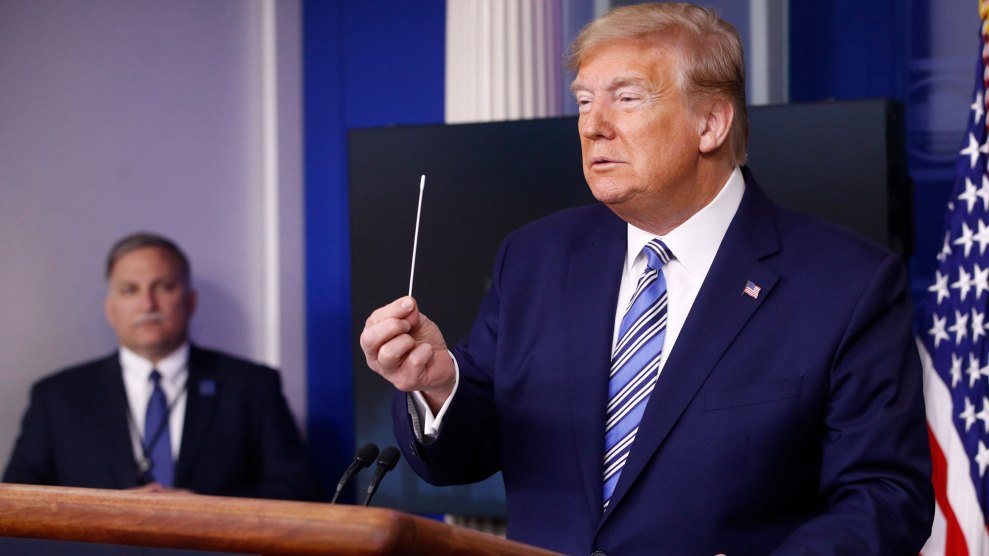
Patrick Semansky/AP
Trump says 4.18 million people have been tested. He claims, again, that testing is expanding "rapidly" and "by millions and millions of people." (We've heard this stuff a lot from the Trump team and it keeps not happening.)
— Daniel Dale (@ddale8) April 19, 2020
As much as Trump would like you believe otherwise, that isn’t actually all that great. As Vox recently pointed out, the United States still lags behind countries like South Korea, Italy, and Canada in the number of COVID-19 tests conducted per million people. The US conducts 12,736 tests for every million people; by comparison, Germany leads the pack at 20,874 tests per million.Trump on testing: "It should be a local thing," but "we're helping them a lot," and we want to help them "more than a lot," if you think about it.
— Daniel Dale (@ddale8) April 19, 2020
Covid-19 tests as a proportion of the population, selected country rankings:
— Brian Klaas (@brianklaas) April 19, 2020
1. Iceland: 12%
10. Norway: 2.5%
18. Italy: 2.2%
20. Germany: 2.1%
21. Spain: 2.0%
31. Australia: 1.6%
34. Canada: 1.4%
37. Russia: 1.3%
38. USA: 1.1%
52. France: 0.7%
55. UK: 0.7%
Source: Worldometer
What’s more, public health experts have insisted widespread testing is necessary to get a better gauge of how widespread the coronavirus is nationwide. And Harvard researchers recently found that the country’s daily testing needs to triple by mid-May for the country to safely reopen.As long as President Trump continues to lie about this, heres the list of countries who have done more per capita COVID19 testing than the USA. I’ve ordered the countries by tests per million inhabitants. Far right column. Check marks by large countries. pic.twitter.com/GZg6BBVToA
— Josh Marshall (@joshtpm) April 19, 2020
Trump wasn’t the only administration official talking up the testing numbers Sunday. Earlier in the day, Vice President Mike Pence went on the morning talk show circuit to say that the 150,000 COVID-19 tests conducted daily were “sufficient for any state in America” to begin lifting restrictions and called on states to activate their labs for more testing. As I wrote earlier today, governors weren’t happy:As Trump vaguely proclaims everything great on testing, the fact is that there are widespread shortages and other impediments, as confirmed by politicians of both parties, and that the US is nowhere near the level most experts say is needed for a safe lifting of restrictions.
— Daniel Dale (@ddale8) April 19, 2020
Pence’s optimism encountered significant pushback from governors on both ends of the aisle on Sunday. “To try to push this off, to say that the governors have plenty of testing and they should just get to work on testing—somehow we aren’t doing our job—is just absolutely false,” Republican Maryland Gov. Larry Hogan told CNN. And Democratic Virginia Gov. Ralph Northam slammed the idea that states have enough testing capacity as “just delusional.”
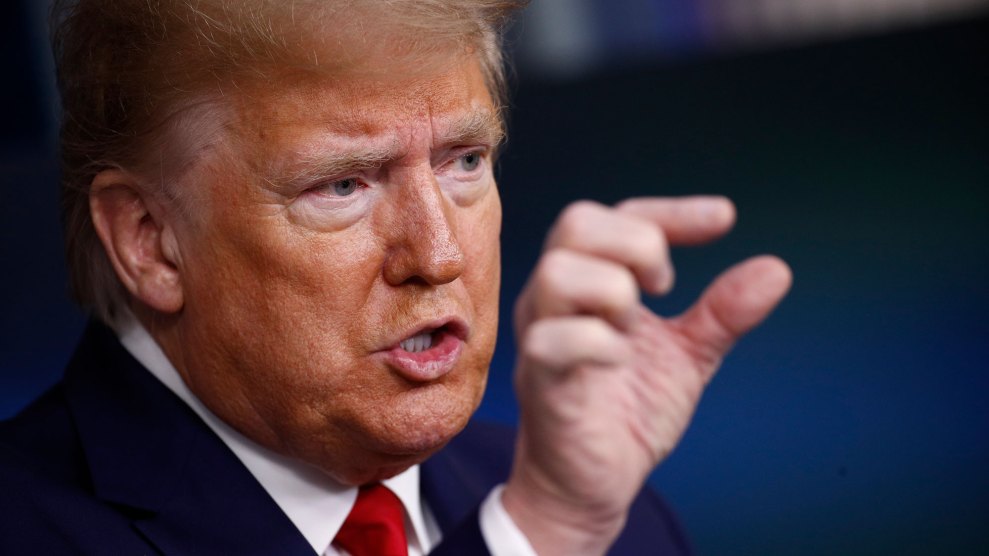
Patrick Semansky/AP
Today is my mom’s birthday, but because I’m on weekend duty and because my parents’ phone has been seemingly busy all day—yes, that’s a thing that can still happen in 2020—I haven’t yet had a chance to talk to her and wish her well. You should be frowning at your screen, furrowing your brows. She’s great and deserves better.
But! At least I have President Donald Trump’s latest coronavirus briefing to keep me informed and engaged while I wait for Mom to finally get off the phone. Let’s see what the prez has to say about COVID-19 today!
Wait…whatttttt the hell is this?!
"It was hard to get it aroused. And it is hard to get it aroused. But we got it aroused." — Trump is now reading a Wall Street Journal op-ed that said nice things about him pic.twitter.com/Syrxttjm3v
— Aaron Rupar (@atrupar) April 19, 2020
To review: Trump read the assembled press a flattering Wall Street Journal piece that included the (really poorly crafted) sentence, “By shouting out many of them by name and documenting their deeds on a daily basis, he has vivified the American way in action (once reluctantly aroused).” Then, completely unable to not turn the briefing room into a middle-school boys’ bathroom, Trump seized on the word “aroused” like only he can:
“It was hard to get it aroused.”
“And it is hard to get it aroused.”
“But we got it aroused.”
Sorry, Ma. I’ll be sure to wash my mouth out with soap before I call.
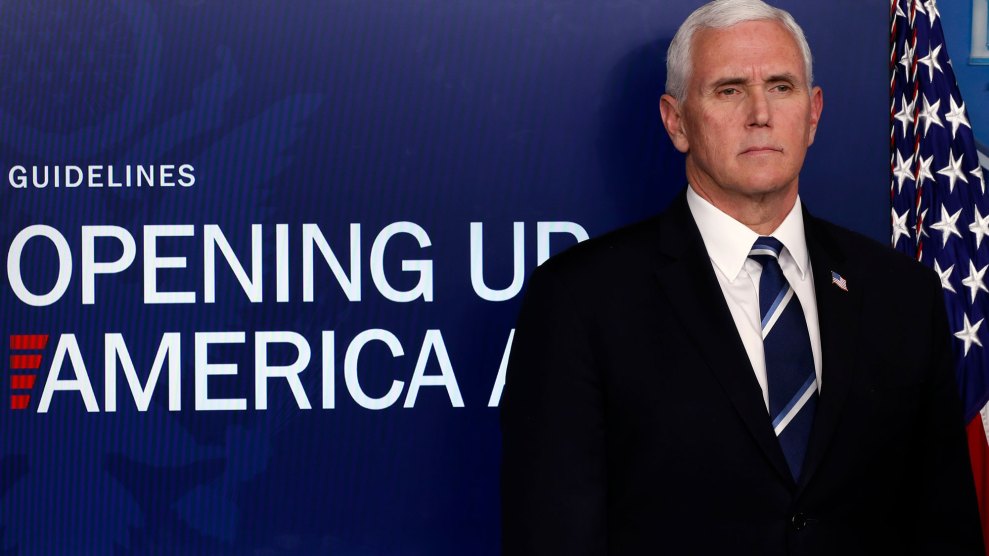
Alex Brandon/AP
Pence’s appearance came after a day after a protest near the state capitol in Austin, Texas, featured a slew of MAGA-hats, conspiracy theory mudslinging, and chants ranging from “Let us work!” to “Fire, Fauci.” That demonstration was one of several right-wing protests in places like Michigan and Maryland that echoed the culture-war battles of the tea party era. In a Saturday afternoon press briefing, Trump defended his tweets by saying that, in some cases, governors had “gotten carried away” with shelter-in-place orders. Pence also noted on Fox News Sunday that the 150,000 COVID-19 tests conducted per day in the United States were “sufficient for any state in America” to begin lifting restrictions. He added that, to double efforts to 300,000 a day, it would require governors to “activate all of the laboratories in their states around the country that can do coronavirus testing.” The problem is that the United States has been doling out fewer tests per capita than several other developed countries. Pence’s optimism encountered significant pushback from governors on both ends of the aisle on Sunday. “To try to push this off, to say that the governors have plenty of testing and they should just get to work on testing—somehow we aren’t doing our job—is just absolutely false,” Republican Maryland Gov. Larry Hogan told CNN. And Democratic Virginia Gov. Ralph Northam slammed the idea that states have enough testing capacity as “just delusional.”WATCH: Why is President Trump trying to undermine guidance for states on social distancing with tweets about "liberating" Minnesota and Michigan? #MTP #IfItsSunday@VP: "The president has made it clear — he wants to reopen America." pic.twitter.com/s39u5tQPzI
— Meet the Press (@MeetThePress) April 19, 2020
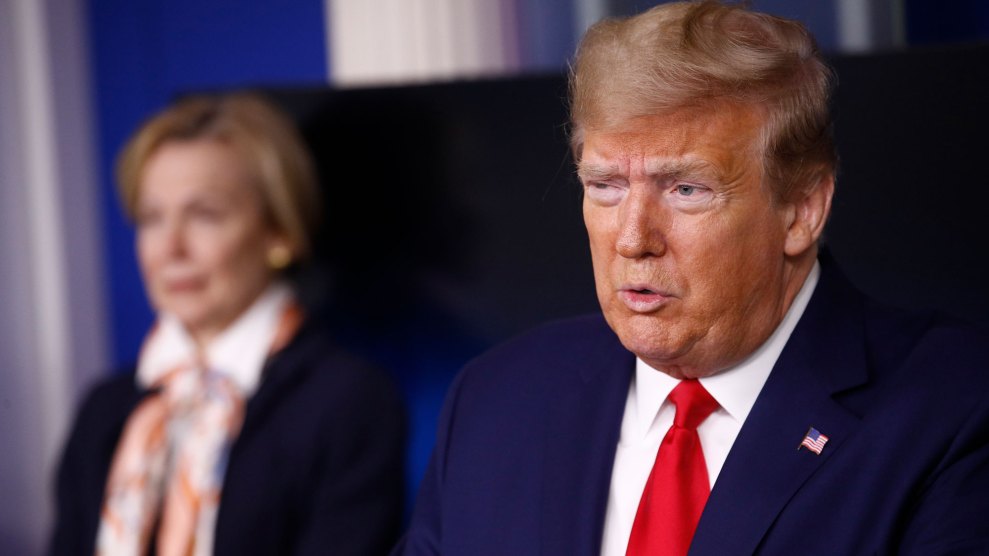
President Donald Trump speaks during a coronavirus task force briefing at the White House on Saturday. White House coronavirus response coordinator Dr. Deborah Birx stands at left. Patrick Semansky/AP
A number of CDC staffers are regularly detailed to work at WHO in Geneva as part of a rotation that has operated for years. Senior Trump-appointed health officials also consulted regularly at the highest levels with the WHO as the crisis unfolded, the officials said. The presence of so many U.S. officials undercuts President Trump’s charge that the WHO’s failure to communicate the extent of the threat, born of a desire to protect China, is largely responsible for the rapid spread of the virus in the United States.Last week, Trump announced that the United States would freeze aid toward the international health agency for 60 days. At a briefing at the White House’s Rose Garden, Trump fixated on the fact that WHO officials didn’t obtain coronavirus samples from Chinese officials and that the organization “failed to investigate credible reports that conflicted directly with the Chinese government’s official accounts.” The move to freeze aid drew broad criticism from Democrats and international allies. On Sunday, when asked whether Trump’s anger toward the WHO was warranted, Dr. Deborah Birx told ABC This Week that, when a pandemic arises, the burden was on “the first country that gets exposed to the pandemic that has a—really, a higher moral obligation on communicating, on transparency, because all the other countries around the world are making decisions on that.”
Pressed on whether Pres. Trump halting funding to the WHO over the COVID-19 pandemic is fair, Dr. Deborah Birx says the first country with infection has "higher moral obligation" to communicate: "That's something we can look into after this is over." https://t.co/UqxIk3URcE pic.twitter.com/180jREYjIO
— ABC News (@ABC) April 19, 2020
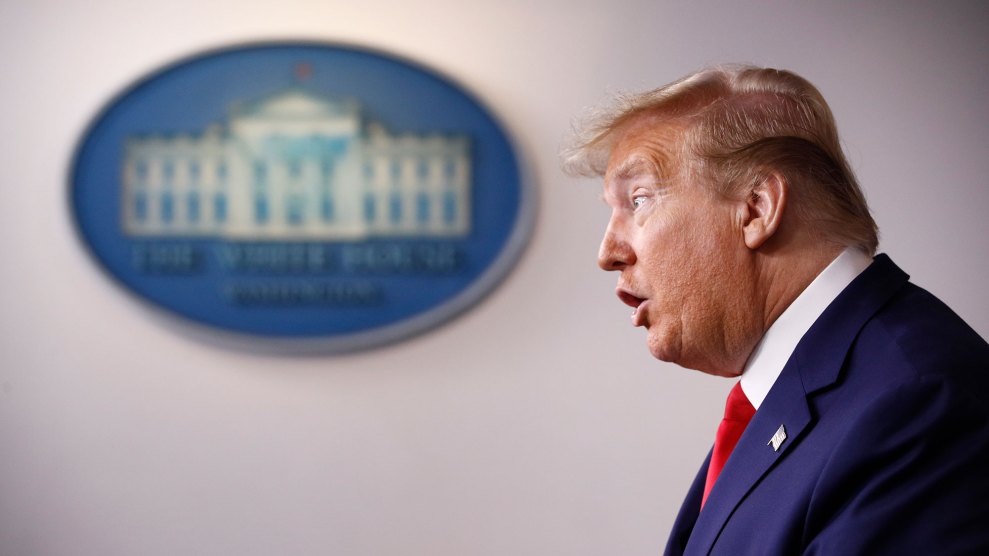
Patricky Semansky/AP
Nancy Pelosi went on Fox News for the first time in nearly three years Sunday morning and was unsparing in her criticism of President Donald Trump, whom she called a “weak leader” and gave an F for his coronavirus testing response.
Naturally, Trump couldn’t help but respond in the most juvenile, grammatically curious way possible:
Nervous Nancy is an inherently “dumb” person. She wasted all of her time on the Impeachment Hoax. She will be overthrown, either by inside or out, just like her last time as “Speaker”. Wallace & @FoxNews are on a bad path, watch! https://t.co/nkEj5YeRjb
— Donald J. Trump (@realDonaldTrump) April 19, 2020
Forgive me, but:
Can someone end my suffering and tell Donald Trump that this is just not how "Language" works? https://t.co/16AOLtFUSf pic.twitter.com/JBFPl65u0s
— Mother Jones (@MotherJones) April 19, 2020
(Alliteration aside, this is exactly why our copy editor, Daniel King, thought it necessary to annotate Trump’s tweets earlier this week.)
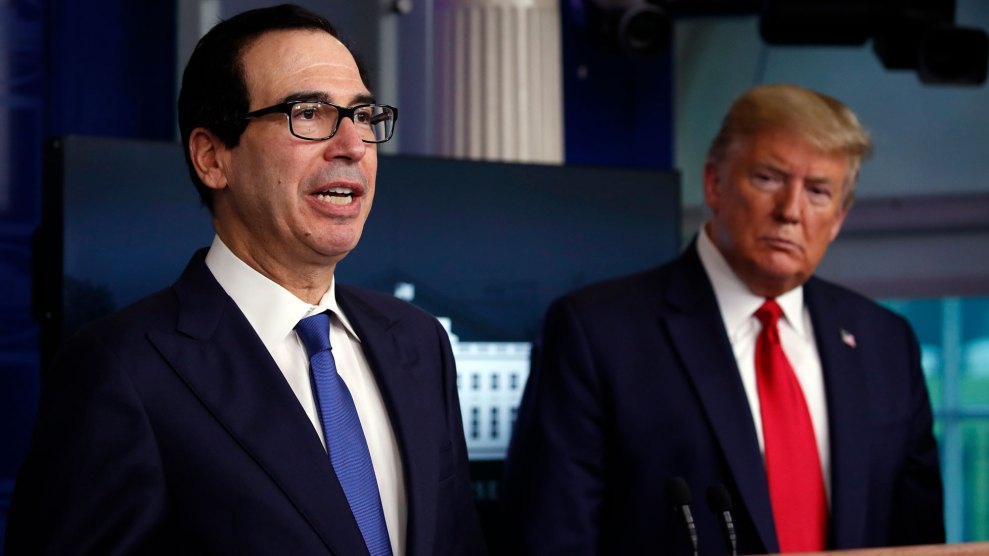
Alex Brandon/AP
During a Sunday morning appearance on CNN in which he said he was “hopeful” a deal on another coronavirus relief bill could come soon, Treasury Secretary Steve Mnuchin wanted to clear up another matter: It was his idea, he told host Jake Tapper, to put President Donald Trump’s name on millions of stimulus checks.
“The President could have been authorized to sign the checks—that would have slowed things down,” Mnuchin said. “We didn’t want to do that. We did put the President’s name on the check—that was my idea. He is the president, and I think it’s a terrific symbol to the American public.”
"That was my idea" — Steve Mnuchin tells Jake Tapper that he, not Trump, was the one who wanted to put Trump's name on coronavirus relief checks pic.twitter.com/ubk40UUK75
— Aaron Rupar (@atrupar) April 19, 2020
Mnuchin’s comments echo reports from the New York Times and Washington Post that the move to put Trump’s name on the checks came at the behest of the Treasury Department. As the Post reported last week:
While Trump has spent recent weeks talking with friends and supporters about his coronavirus response and his reelection campaign, the effort to place his name on the checks was largely kept secret until this week, with top White House officials in the dark until the plan became public. The White House press office did not respond to requests for comment Wednesday.
Some senior officials at the IRS did not find out about the plan until Tuesday morning, underscoring the unorthodox process that has turned Trump’s desire into reality.
After privately suggesting to Treasury Secretary Steven Mnuchin that he be allowed to formally sign the checks, Trump settled for having his name printed in the memo section, according to administration officials, who spoke on the condition of anonymity to discuss internal deliberations.
Meanwhile, the impending $400 billion deal between the Trump administration and congressional Democrats would send $300 billion to a small business loan program, $75 billion to hospitals, and $25 billion toward testing. But even as congressional Democrats have requested more money to be sent to states directly, Mnuchin argued that the federal government already had “a lot of money that we’re distributing to the states.”
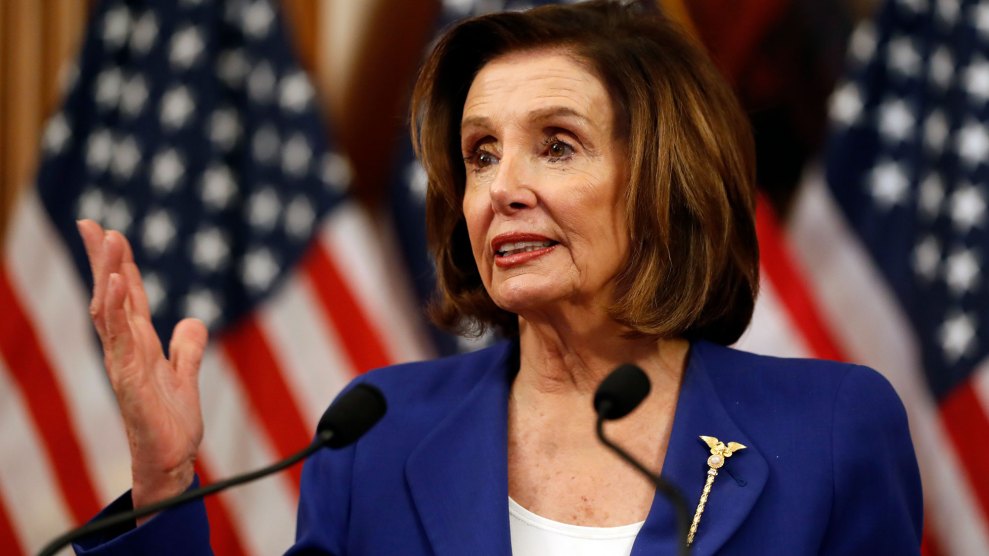
Andrew Harnik/AP
Her comments came as Treasury Secretary Steve Mnuchin indicated on CNN that the Trump administration and congressional Democrats could reach an agreement on yet another aid package would include $300 billion to replenish funds for a federal small business loan program that ran out last week. Mnuchin said he hoped the Senate would pass the deal—which also includes $75 billion for hospitals and $25 billion for testing—on Monday, followed by a House vote on Tuesday.Pelosi on Fox News Sunday: "The president gets an F — a failure — on the testing. But Dr. Fauci is right — 'if it's done properly' — it hasn't been." pic.twitter.com/e57i1nE7lX
— Aaron Rupar (@atrupar) April 19, 2020

An empty picnic area.Tracy Barbutes/Zuma
This piece was originally published in High Country News and appears here as part of our Climate Desk Partnership.
As the COVID-19 pandemic takes hold across the country, residents are called to practice public health measures in our parks and the outdoors. This includes practicing social distancing and avoiding outdoor recreation towns that cannot afford the risk of caring for infected visitors.
The message has been straightforward: Stay away from these towns and public lands; if you’re irresponsible, we’ll close the trails and parks down. At the same time, suggestions and guidelines are offered on how we can still get outdoors safely: Stay close to home, engage with nearby nature, and hike in your neighborhood. These instructions are necessary, but they are based on the assumption that everyone has the privilege of outdoor access and will be affected the same when it is taken away.
As the founder of Latino Outdoors, a Latinx-led organization that connects the diversity of Latinx communities with the outdoors, and someone who has spent years working to make the outdoors a more equitable space, I think it’s important to keep frameworks of equity and inclusion in mind, especially during times when inequalities are being amplified. If we don’t, we risk perpetuating existing inequities that have a real cost in terms of the health of communities of color as well as others who have historically lacked equitable access to the outdoors.
Across the West, people of color have long experienced unequal access to outdoor spaces. In a 2018 study, researchers David Scott and KangJae Jerry Lee note data from the National Park Service Visitor Services Project showing that Hispanics and Asian Americans comprised less than 5 percent of visitors to the national parks surveyed, while fewer than 2 percent were African Americans. The 2018 Outdoor Industry Association Participation Report put ethnic outdoor participation percentages for whites, Hispanics, Blacks and Asian Americans at 74 percent, 10 percent, 9 percent and 6 percent respectively.
One study by the University of British Columbia found that while income and education are strong factors, “racial and ethnic factors show stronger negative associations with urban vegetation in larger cities.” In other words, white residents had more positive associations with green spaces than Latinx and African American residents did.
So how do we avoid harming communities of color by sending them yet another message to stay away from the outdoors? We can first assess and acknowledge the impact our messaging might have on some of these populations.
As Nina Roberts, professor at San Francisco State University, and Caryl Hart, commissioner at the California Coastal Commission, wrote in their article “To Close or Not To Close,” which appeared in Bay Nature at the end of March, these closures compound an existing problem. “Generally, by preventing people from obtaining (park) benefits and more, even amidst a pandemic, we create additional problems not solutions,” they wrote. “Furthermore, other research also shows how low income and other under-resourced communities incur greater stress due to lack of access to parks in times of need.” This makes it clear that in addition to having to cope with a global pandemic, these communities disproportionately face physical and mental health problems that are amplified when the parks are closed.
As we move forward, it is important to take into account the human need to connect with the benefits of nature and the outdoors—especially when it comes to the most seriously impacted populations—while protecting the public health of everyone.
Parks and agencies, for example, can use this time to better ensure public health for disproportionally impacted populations by working with community-based leadership through groups and coalitions. The Parks Now Coalition in California and the Next 100 Coalition in Colorado, for example, are already invested in making the outdoors a more equitable place. Both groups were formed to increase park and outdoor access for underrepresented communities.
In the West, we have other good models to follow when it comes to ensuring equitable access to the outdoors during COVID-19: Cities like Denver, Colorado, for example are blocking off streets to cars to provide more recreational space for urban residents. Such efforts have similar effects to “pop-up parks,” the temporary reuse of space to provide park benefits. Other cities, including Oakland, California, have recently followed suit; Oakland opened up 74 miles of streets to walkers, joggers and cyclists.
The outdoor recreation and conservation community could do its part by shaping its messaging around going outdoors ethically with an eye toward equity. Helpful messages might include:
Reflect on what it means to have restricted outdoor access now that you are experiencing it, and consider that this has long been the norm for others.
Donate, if possible, to a community-based organization that supports outdoor access—much as you would to a food bank.
Speak up as an anti-racist ally when you are in public spaces, especially given the current rise in anti-Asian hate crimes.
Without such actions and considerations, I’m concerned that our decision to limit and close off park and outdoor access will take a disproportionate toll on the communities that need it the most, even as we debate the issue in our privileged spaces.
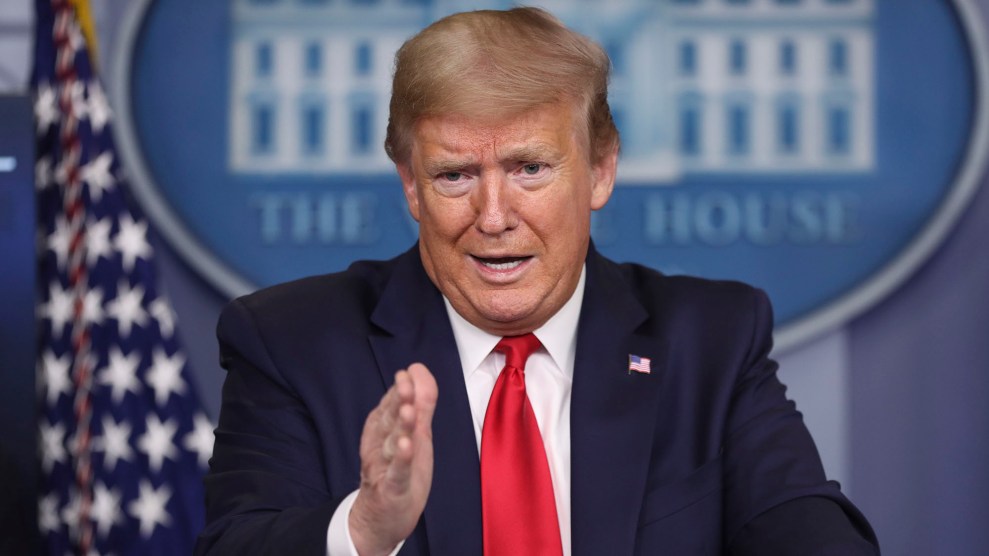
April 17, 2020, Washington, District of Columbia, USA: United States President Donald J. Trump speaks during a press briefing with members of the coronavirus task force in the Brady Press Briefing Room of the White House on April 17, 2020 in Washington, DC (Credit Image: © Oliver Contreras/CNP via ZUMA Wire)
On Saturday, Donald Trump promoted a tweet from a conservative author who was just-asking-questions: would mosques be subjected to the same social-distancing restrictions during Ramadan as churches were during Easter?
Let's see if authorities enforce the social-distancing orders for mosques during Ramadan (April 23-May 23) like they did churches during Easter
— Paul Sperry (@paulsperry_) April 15, 2020
It’s sort of a weird premise. Is the idea that Muslim places of worship are typically treated more generously from local governments and law enforcement? Activists from New York City to Murfreesboro, Tennessee, have tried to block Muslim residents from even building mosques; mosques have been subjected to (sometimes unconstitutional) surveillance; and the current president of the United States ran for office on literally banning Muslims from entering the United States. In any event, social-distancing guidelines in some parts of the country might be very different in late May than they were on Easter Sunday, which was during the heart of the pandemic.
At his press conference on Saturday evening, a reporter read the tweet back to the president.
“I would like to see that,” Trump said. As in, he too was wondering if local authorities would treat mosques differently than churches.
“You know I just spoke with leaders and people that love mosques,” he continued. “They love mosques! And I’m all in favor of that. But I would say that there could be a difference. And we’ll have to see what will happen. Because I have seen a great disparity in this country. I’ve seen a great disparity. I mean I’ve seen a very strong anti-Israel bent in Congress with Democrats. It was unthinkable seven or eight or 10 years ago, and now they’re into a whole different thing. Between Omar and AOC—I saw AOC plus three, add them on. You have, the things that they say about Israel are so bad. And I can’t believe it. Just a minute. So I would be interested to see that. Because they go after Christian churches but they don’t tend to go after mosques. And I don’t want them to go after mosques! But I do want to see what their event is—”
There was a weird digression there, from a question about a religious holiday to a rant about Democratic critics of the Israeli state. So the reporter followed up: was he suggesting that imams wouldn’t follow social-distancing guidelines?
“I just had a call with imams,” Trump said. “I just had a call with ministers, rabbis. We had a tremendous call with the faith leaders. No, I don’t think that at all. I am someone that believes in faith. And it matters not what your faith is but our politicians seem to treat different faiths very differently. And they seem to think and I don’t know what happened with our country, but the Christian faith is treated much differently than it was, and I think it’s treated very unfairly.”
There’s a lot that’s wrong there, but you can’t argue with “our politicians seem to treat different faiths very different.” Just look at the current occupant of the Oval Office himself.
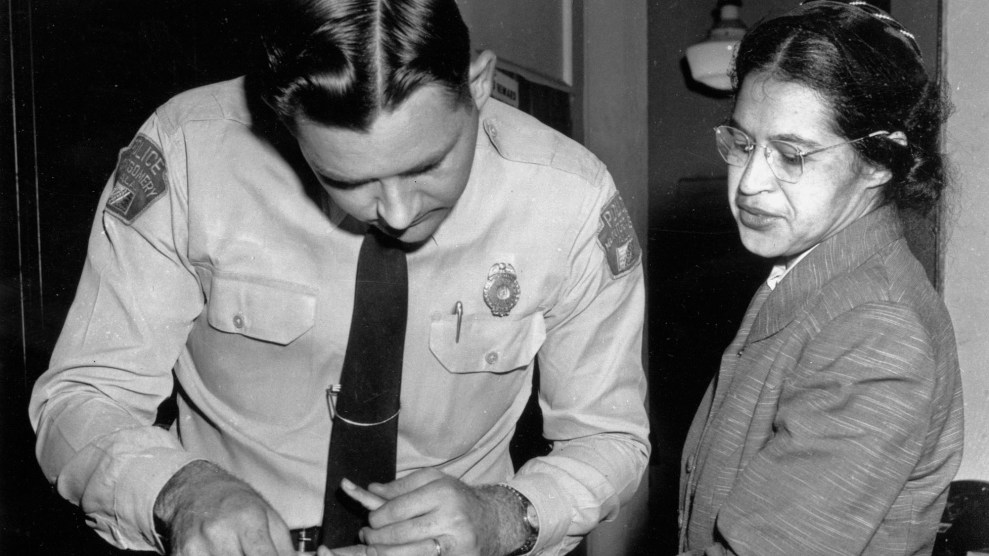
Rosa Parks is fingerprinted in Montgomery, Alabama in 1956.Gene Herrick/AP
Egged on by well-funded political activists, Fox News, and President Donald Trump himself, protesters convened on state capitals in Michigan, Minnesota, and other states this week to demand an end to extreme social-distancing measures designed to combat the spread of coronavirus. The protests, complete with “Keep America Great” banners and in one case, a Confederate flag, have the look and feel of a Trump reelection rally, and they have come as governors in these states—which include Democrats and Republicans—announced that they were still weeks away from being able to “re-open” non-essential businesses. If you, like me, are horrified at the daily death toll and feel besieged by the constant blaring of ambulances, the sight of a mass of people standing in close proximity without any sort of protective covering feels not just anachronistic but infuriating—a significant number of people, apparently, are willing to throw away whatever was achieved by social distancing just for the fleeting illusion of individual freedom.
But if you’re Trump economic advisor Stephen Moore, you see something much different. In an interview with the Washington Post on Friday, Moore compared the large gatherings of angry white conservatives to…civil rights icon Rosa Parks:
“I think there’s a boiling point that has been reached and exceeded,” said Stephen Moore, a conservative economist. Moore is a member of both the White House council to reopen the country and a coalition of conservative leaders and activists seeking to push government officials to relax stay-at-home orders.
“I call these people the modern-day Rosa Parks—they are protesting against injustice and a loss of liberties,” Moore said of the protesters.
Moore, you may recall, was nominated for a seat on the Federal Reserve last year, only to withdraw amid a firestorm over his past comments about, well, seemingly everything. Also: he had no relevant expertise on monetary policy, and described himself as “kind of new to this game, frankly.” Also, he once said this:
.@StephenMoore explains his 2016 joke about Donald Trump moving into the White House and kicking “a black family out of public housing.” Moore says, “That is a joke I always made,” adding he didn’t mean it “like a black person” lived there. “I shouldn’t have said it,” he says. pic.twitter.com/9EO9JzBgtW
— Firing Line with Margaret Hoover (@FiringLineShow) April 30, 2019
The pandemic is a civil rights issue, but it’s not because people in Michigan can’t manicure their lawns. The pandemic has exploited racial inequities across the country. As my colleagues Edwin Rios and Sinduja Rangarajan reported yesterday, “in 20 of the 28 states plus DC for which a usable racial breakdown of infection data was provided, Black people make up a larger share of coronavirus infections than they do of the general population.”
In New York at least, it’s also ravaged public transportation systems, whose employees—disproportionately people of color—are considered essential workers. I don’t want to give Moore’s argument too much credence but suffice to say that Rosa Parks did not take her stand so that Black people could die in overwhelmingly disproportionate numbers during a pandemic.

A cloud of locusts flying in Mwingi North, Kenya.Fred Mutune/Zuma
This piece was originally published in Wired and appears here as part of our Climate Desk Partnership.
As the coronavirus pandemic exploded across the world earlier this year, another even more conspicuous plague was tearing through East Africa: locusts. The voracious little beasts are particularly fond of carbohydrates like grains, a staple of subsistence farmers across the continent. Back in January, the UN Food and Agriculture Organization (FAO) predicted the worst was still to come, and that by June, the size of the swarms could grow by a factor of 500.
And now, at the worst time, a second wave of locusts 20 times bigger than the first has descended on the region, thanks to heavy rains late last month, according to the FAO. The swarms have infiltrated Yemen and firmly established themselves across the Persian Gulf, having laid eggs along 560 miles of Iran’s coastline. New swarms are particularly severe in Kenya, Ethiopia, and Somalia.
“The timing is really horrendous, because the farmers are just planting, and the seedlings are just coming up now since it’s the beginning of the rainy season,” says Keith Cressman, senior locust forecasting officer with the FAO. “And it’s right at the same time when you have an increasing number of swarms in Kenya and in Ethiopia. There’s already pictures and reports of the seedlings getting hammered by the swarms. So basically that’s it for the farmers’ crops.”
“This represents an unprecedented threat to food security and livelihoods,” FAO officials wrote in a brief last week. All this is happening while the region locks down to stave off the coronavirus pandemic, and as travel restrictions mean experts can’t get to countries to train people. It’d be hard to imagine a more brutal confluence of factors. “The problem is that most of the countries were not ready, and are now invaded with swarms,” says ecologist Cyril Piou, of the French Agricultural Research Center for International Development, which helps economically developing countries with agricultural issues. “The solution is to try to control as much as you can.”
It would also be hard to imagine a more perfect enemy than the locust: in this case, the desert locust, one of the 20 species of normally solitary grasshopper that go “gregarious,” forming into swarms that can travel 90 miles in a day. Their transformation and swarming is triggered by rain; desert locusts can only lay their eggs in moist sand, since dry sand would cook them. After a storm, the locusts breed like crazy, packing a single square meter of sand with perhaps 1,000 eggs.
When those eggs hatch, the baby locusts find themselves in a newly lush environment loaded with food. They’ll strip it clean and take off in swarms in search of ever more vegetation to obliterate. Their bodies actually transform to prepare them for the journey; their muscles grow bulkier, and their color changes from a drab brownish green into an electric yellow and black. This color shift probably has to do with the gregarious locusts now eating the toxic plants they had previously avoided as solitary insects: That bright coloration warns predators that they’re toxic as a result of their diet. If they were this color when they’re solitary, they’d stick out to predators, but as they gather in their billions, it’s not like they need to be inconspicuous anymore. There’s safety in extreme numbers.
This particular outbreak began with heavy rains from two cyclones in May and October of 2018 that hit the southern Arabian Peninsula. This allowed two generations of desert locusts to form into swarms. Each generation can be 20 times bigger than the previous one. “The main problem is that these exceptional rains occurred in an area where there’s a lot of insecurity, wars, and so on, so the initial stages of the upsurge of the outbreaks were not detected in time,” says entomologist Michel Lecoq, former director of the French Agricultural Research Center for International Development.
This lapse in detection unfolded despite the best efforts of the FAO, which coordinates a complex network of data collectors to detect the locusts early, before they have time to go gregarious and swarm. They work with two dozen frontline countries between East Africa and India, with people patrolling in trucks, looking for the pests. They marry this on-the-ground information with satellite data that shows vegetation forming—an indication that hungry locusts could well follow.
Unfortunately, though, the locust boom in 2018 unfolded in Oman’s remote deserts, so there was no one around to raise the alarm. “We can help in creating better models, better forecasts,” says Piou. “But if there’s nobody on the ground, there’s no humans, then it’s not enough. We cannot replace humans on the ground with satellites.”
The terrifying reality is that if you don’t stop a locust swarm early, there’s very little you can do to stop its spread. These insects do not respect borders, and they do not respect crops. Once the swarm arrives, the best officials can do is deploy pesticides to attenuate the crop destruction. But that, too, requires humans, and specially trained crews at that—you can’t just hand a farmer a barrel of pesticide and hope no one gets sick.
Luckily, countries currently invaded by locusts, like Kenya and Ethiopia, already have plenty of experts who know how to run a spraying operation. The concern is for what will happen if the swarms spread into countries like South Sudan and Uganda, which haven’t seen major outbreaks for decades. “They don’t have any national locust program in their country within the ministry of agriculture,” says Cressman, of the FAO. “They have no physical setup, but they also have no expertise, no trained staff in the various aspects of controlling locust.” With travel restrictions in place, experts can’t get there to train people up. And even if they could get there, social distancing means you can’t fill up rooms for lessons on locust control.
The good news in all this is that while shipments of pesticides and spraying equipment to Africa may have slowed as supply chains slow in general, this particular supply chain is distributed across the globe. “It’s coming from the four corners of the planet,” says Cressman. “So we’re not just relying on one region to supply us, which could be a bit risky, because if that region really shuts down, you wouldn’t be able to sustain the supply.”
Still, the timing of it all is catastrophic: locusts in the age of the coronavirus, with the start of the harvest season coming in late June and early July. “And unfortunately that’s exactly the same time when the next generation of swarms will be forming,” says Cressman.
With nations elsewhere wrapped up in fighting the coronavirus pandemic, the growing locust threat may not get the attention, and humanitarian aid, it needs. A locust outbreak, Cressman says, is a lot like a wildfire: Put it out early, and you’re good. Delay, and the swarm will spread and spread until it runs out of fuel—the food that subsistence farmers across Africa rely on to survive.
The good news is that the swarms haven’t yet spread through North and West Africa. The bad news is that the magnitude of this outbreak rivals that of the devastating swarms that hit the continent 75 years ago. Beginning in 1948, locusts multiplied out of control in Africa, and didn’t stop until 1963. “So if we don’t stop it now,” Piou says, “we are going to have swarms rolling from country to country.”
To keep that from happening, Piou is working with countries in the region to predict where the locusts might land next. “What we are trying to do with them is to be ready as soon as the swarms arrive,” he says, “to have a quick answer and not let them reproduce again and exponentially grow again.”